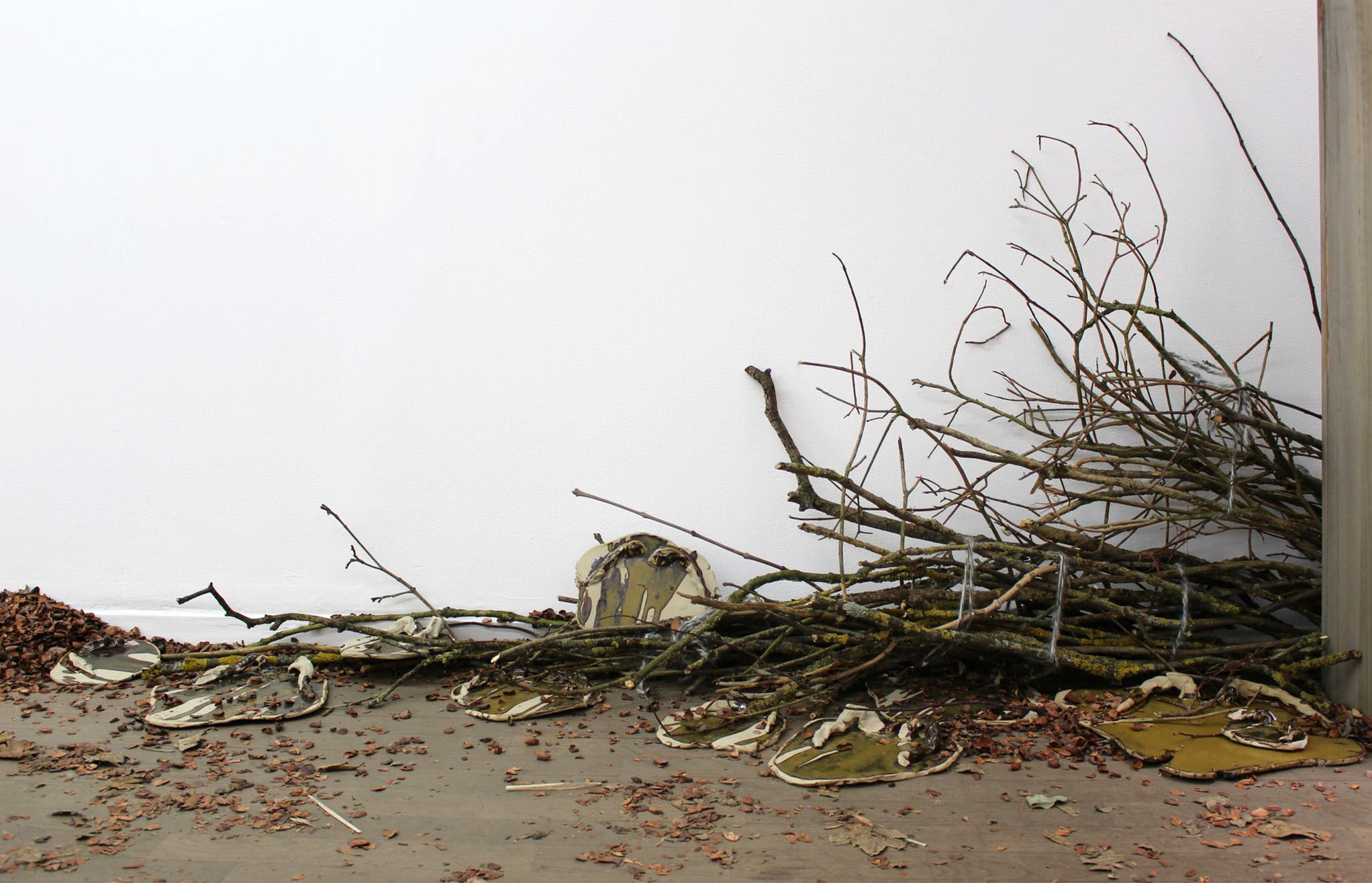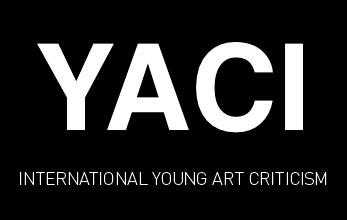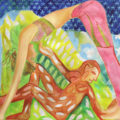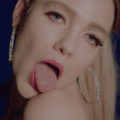Florian Mermin or the elegiac domains
The earth and bark smother the visitors’ steps. We are actually in a gallery, but the works are discovered in a smell of undergrowth and almost by detour. Florian Mermin designs his exhibitions or installations with every nook and cranny in mind. Here a pair of ceramic shoes, there dried apple cores further highlight the olfactory and narrative dimension of the journey. For the person who claims to be above all a sculptor and creator of objects, it is not a question of simply showing pieces but rather of creating a universe in which to integrate them. The same play can circulate from one place to another to tell different stories, depending on the associations or the staging and the lights. It is important that the visitor feels physically involved; one can project oneself into a night in the forest, an afternoon of tea or a twilight by the sea. Undoubtedly, the fact that the artist also sought to create through video games a space-time where one can walk around like in a dream is not to be neglected. Particularly concerned about how a visitor can enter an artistic work, in a general and conceptual way, he seeks to make it active through different sensory stimuli.

The titles of the different hangings introduce in each case a particular imagination, a lyricism and a promise of narration. Caresse de forêt ( le soir où tu m’as quitté) (Caress of the forest ( the evening where you left me)) at Backslash Gallery in 2019 evokes a rupture as much as a space of intimacy and communion with nature. J’ai laissé la lumière du jour ( I left the light of day) at Un-spaced Gallery in 2018 or Replanter des choses oubliées (Replant things forgotten) in 2017 at the Salon de Montrouge, to mention only the most recent ones, also offer singular lighting on the pieces exhibited with the organic space of a winter garden or the more spiritual one of a kind of chapel at the Moon. Although Florian Mermin claims not to work on the written word, apart from his titles, he nevertheless develops a poetics of space. Starting from reality, since his diary is essentially photographic, he tries, especially through fiction, to make us go beyond our experience of reality. It brings into the gallery, compost, bark and branches of fir trees full of sap to evoke organic landscapes where flowers can wither. The places he imagines are filled with signs that the visitor is led to assemble through a circulation, a narrative. The story is indexical, a rose in different states of decomposition that can be seen by sticking its eye against a wooden trunk, or scattered clothes in the exhibition, such as a constellation of rose petals on a garbage bag suggests everything about the end of the love feeling without affirming anything.

Florian Mermin is gradually building Caresse de forêt (le soir où tu m’as quitté) with ideas for pieces that have never been made and a willingness to talk about the relationship between the living species that surround us, whether they are human, animal or vegetable. “The title “he said “came a little like a perfume name […] it suggests something hybrid and a questioning of the characters in the exhibition : who is talking ? who left ? who left ? who got left ? who was left ?”. The fictional accent of his exhibitions is for the artist the way to “divert” the autobiographical inspiration from his work or rather to sublimate it. Hair that slips into the sap and sticks to the wood or hair embedded on the leaves gives the feeling of an extension of the human being through the forest. The works he presents in the exhibitions play for him the role of a character in a story, as well as the set of three trees cut from pine wood, Les sentiments ombragés (Enshadowed Feelings) in 2019, has the artist’s size in height as in terms of shoulder width. This disturbing and emotive nature evokes a form of romanticism as he himself claims. A close look at the landscape allows us to assess the extent of a disappearance. The evolution of feelings can be seen particularly in the motif of the rose, which is not without taking up the symbolism of Beauty and the Beast.

At times, in the face of Florian Mermin’s work, we can think of Cocteau’s film, with its hooks that evoke brambles, its carnivorous ceramic plants that evoke a violent and passionate nature. Their position would not be so far away if we took up the director who spoke of the tricks of The Beauty and the Beast at his word, saying “it’s because I want real unreality that allows everyone to dream the same dream together. This is not the dream of sleep. It is the standing dream of unreal realism, the truer than the true one.” Many of Florian Mermin’s sculptures borrow from the vocabulary of the domestic or furniture and can be identified, for example, as a vase, tea set or bench, while remaining authentic sculptures. The artist enjoys experimenting with limits and exploring this moment when the functional aspect of an object can disappear in favour of an art object. The fake even in a way. “Sometimes the shape of the object contradicts its original function as vases split at the bottom, a bench of thorns, a mirror that no longer reflects, shoes too hard to wear. Or it happens that the protocol of the objects contradicts the function of a supposedly functional object such as a vase made to accommodate only living flowers deprived of their water. “One could think of Giacometti’s unpleasant objects, for example, when the weight of the piece contradicts its function, such as a heavy ceramic vase that is difficult to handle, but it is sometimes the ornament that thwarts the object’s function because of its fine, delicate or poorly designed fragilities that make the use of the piece dangerous.

Florian Mermin’s ceramics have natural shapes or patterns that evoke a long tradition in the history of decorative arts and that sometimes remind us of Bernard de Palissy. The use of pieces of nature in the exhibition space is for him a way to create a repetition, which underlines the sensitivity of the materials but also to install a tension. In the exhibition, the idea of hide-and-seek and the true and the false is played out. The materials evoke others or play with trompe-l’oeil. Who is the copy of whom? We are in a world of transformation, metamorphosis and evolution where very contrasting materials and even recovered objects coexist. “The combination of industrial and handmade materials comes together spontaneously, they are part of a base of materials that are part of my environment, that mix in everyday life like the Ikea piece of furniture made of reconstituted wood that awaits the garbage truck on the sidewalk, leaning against a tree. »
The question of art and craft came up a few years ago in Florian Mermin’s work, who is very interested in the production of popular cultures: macramé, curtains, tapestries… William Morris’ reading of art and craft can also be felt in his production, which resists the standard and makes irregularity, fantasy one of the last bastions of feeling and humanity. In the artist’s poetic forests and natural reserves, ceramics encourage people to walk and become elegiac.






